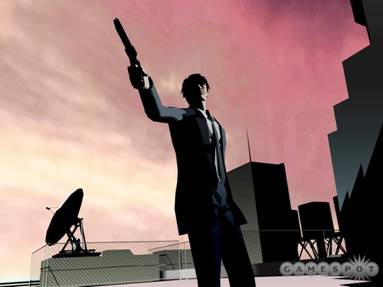So Now you know
what a texture is, i know you may be thinking, "What does a texture have
to do with Cel-Lighting? Well, I'll answer that in a minute.
I already explained
how conventional lighting is different from Cel-Lighting, which is why
the first things cel-shaders do is disable their conventional lighting.
This means that Cel-shaders have to create their own lighting engine. If
you've read the article "Making a lighting engine" under the theory
section, then you probably had questions like, "What the heck is a dot
product?" Well, it has to do with how directional lighting is
calculated. basically, for every vertex on an object, there is it's
position, and it's lighting normal. the position identifies it's
co-ordinates in 3D space, (usually in the form X,Y,Z) while the lighting
normal contains a vector. A Vector is described in physics as a
quantity with both direction and magnitude. the same goes for Vector's
in 3D graphics.
Okay, let me take a
step back for a moment and explain were I'm going with this. We are
trying to program a basic lighting engine, conventional wisdom tells us
that the sides of an object closest to the light will be the brightest,
right? So we need to make sure that when we draw an object on screen
(like a cube) we want the corner closest to the light to be the
brightest. In order to do that, we need to figure out which of the
vertex's (corners) is closest to the light, before we can do THAT, we
need to be able to calculate the distance between a light source and the
corners of an object drawn in 3d space.

Remember above, when i said that "every vertex on an
object, there is it's position, and its lighting normal"? Well, see that
picture above? Each one of those vertex's (corners) has a position that
identifies it's location in 3d space, those green lines coming out of
the vertex's are the vertex's normals. Normal's are vectors, they have a
start point and an end point, In 3d graphics only one vertex is needed
to identify a normal, because it's start point is identified by the
vertex it's attached to. Lighting engines will Normalize the
normal vectors, which is just a fancy way of saying "cut the length of
the normal down to a number less than 1"
Now that we have an
object's normals, we can calculate the Dot Product, which is a
useful method for calculating the angle between two vectors.
So basically,
programmers use the dot product to calculate the angle between the
vertex normal and the light direction. This angle can then be used to
shade the object accordingly.
I'm not going to go into how to calculate the dotproduct, or how to
normalize a vector, read the Nehe tutorial (the link is under the CODING
section) it details the math involved in calculating those things, I
just explained what these things ARE, so when you read the tutorial, you
will know what he is talking about.
The lighting engine mentioned above would light
objects the same way that conventional lighting routines do, which is
what we DON'T want, so how do we get the broken up "color-banding" or
cel-lighting that we want? Well, that's were the Texture thing comes in.


